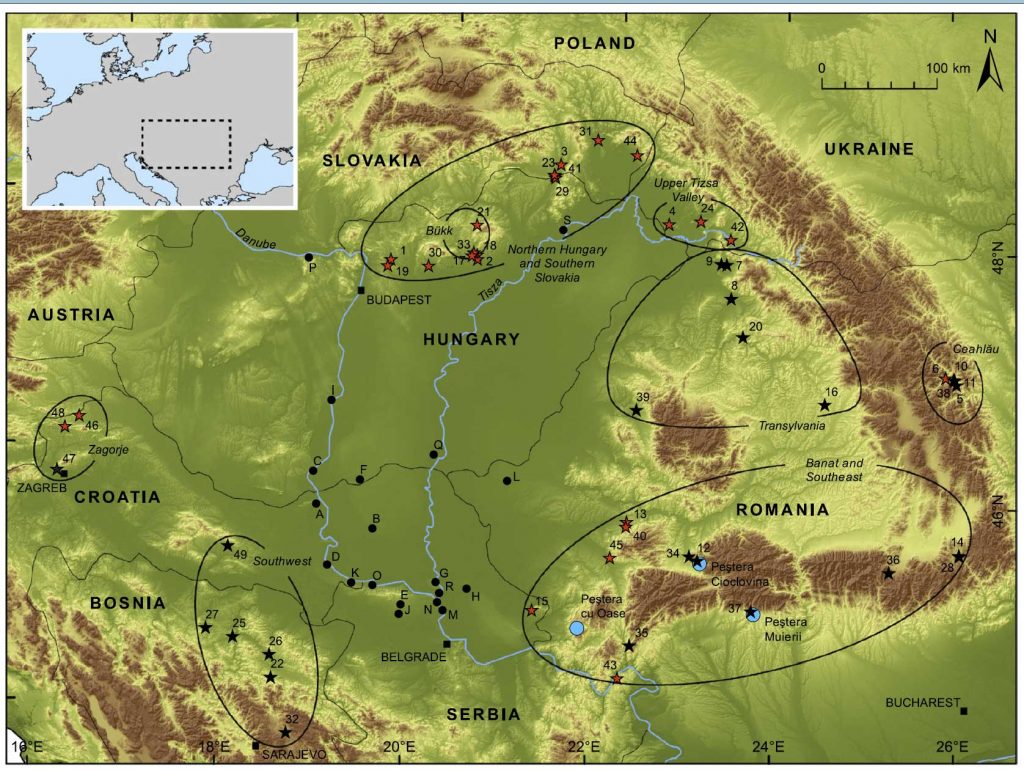Open access review, The Danube Corridor Hypothesis and the Carpathian Basin: Geological, Environmental and Archaeological Approaches to Characterizing Aurignacian Dynamics, by Wei Chu, J World Prehist (2018).
Abstract (emphasis mine):
Early Upper Paleolithic sites in the Danube catchment have been put forward as evidence that the river was an important conduit for modern humans during their initial settlement of Europe. Central to this model is the Carpathian Basin, a region covering most of the Middle Danube. As the archaeological record of this region is still poorly understood, this paper aims to provide a contextual assessment of the Carpathian Basin’s geological and paleoenvironmental archives, starting with the late Upper Pleistocene. Subsequently, it compiles early Upper Paleolithic data from the region to provide a synchronic appraisal of the Aurignacian archaeological evidence. It then uses this data to test whether the relative absence of early Upper Paleolithic sites is obscured by a taphonomic bias. Finally, it reviews current knowledge of the Carpathian Basin’s archaeological record and concludes that, while it cannot reject the Danube corridor hypothesis, further (geo)archaeological work is required to understand the link between the Carpathian Basin and Central and Southeastern Europe.
Interesting excerpt:
Though the Carpathian Basin record currently supports the idea of an exogenous, early entrance of the early Upper Paleolithic into the Carpathian Basin unrelated to any of the preceding MP or transitional industries, the dispersal across the Carpathian Basin is not suggestive of rapid demic expansion, as is evidenced by the relatively late hybridization of the Peștera cu Oase fossil and implied by persistent Mousterian technological elements (Fu et al. 2015; Horvath 2009; Noiret 2005).

This begs the question of where the makers of the early Upper Paleolithic in the Carpathian Basin came from. Aside from a handful of Aurignacian sites (e.g. Bacho Kiro, Temnata) and Kozarnika, whose link to the Aurignacian remains tenuous, no other sites directly connect the Carpathian Basin Aurignacian to the south in the Balkans. Additionally, Anatolia has also to provide empirical evidence of a connection between Southwestern Europe and the early hominin technocomplexes of the Levant. Therefore, a western source for the Carpathian Basin early Upper Paleolithic is conceivable, especially considering the early Willendorf dates which, if correct, pre-date any of the evidence in the Carpathian Basin. If the Danube was as easy a conduit as has been suggested, it is equally likely that it may have seen hominin movement in the opposite direction (Sitlivy et al. 2014). Indeed, increasing genetic and archaeological evidence (Adler et al. 2008; Anikovich et al. 2007; López et al. 2016) supports the idea that the earliest modern humans coming from the Middle East and into Europe may have bypassed Southeastern Europe (at least overland), opting for a route running through the Caucasus, dispersing east through the East European Plain and then north of the Carpathians.
The recent reanalysis of Central European early Upper Paleolithic assemblages and possibly Initial Upper Paleolithic sensu lato finds farther east in the geographically connected Moravian Plains (Bohunician) suggests that early modern humans were present in Central Europe far sooner than previously recognized (Müller et al. 2011; Nigst et al. 2014; Richter et al. 2008, 2009). This notion could lead to a major modification in our understanding of the origin and cultural ontogeny of the Aurignacian technocomplex (Sitlivy et al. 2014).
This suggests that while hominins were undoubtedly present within the Middle Danube catchment in the late Upper Pleistocene, it is currently difficult to tell from the archaeological record whether they entered the Carpathian Basin on direct ‘highways’, in waves (Hublin 2015), or more piecemeal; furthermore, the evidence is too sparse to suggest a directional trajectory. Indeed, the gap in the Danube record suggests that the situation may be more complicated than has previously been thought. Furthermore, climatic reconstructions, illustrated by advances in loess stratigraphy, faunal/floral records and geochemistry, suggest a necessary diversion from the rugged karstic regions of the basin that may have been more familiar hunting areas for previous (Neanderthal) populations. This may have resulted in more frequent or seasonal use of the lowlands within the earlier parts of MIS 3 that may have prompted subsequent modifications in hominin subsistence behavior. A prolonged/intense modern human presence in the Carpathian Basin throughout the late Upper Pleistocene is testified to by a higher frequency of lithic sites with increased artifact density. Increased sedimentation rates in the later part of the Pleistocene may have also helped to offset the palimpsest effect that might have skewed the record.
Related:
- Palaeolithic and Mesolithic connections between Italy and the Balkans, and the potential expansion of the Villabruna cluster and haplogroup R1b in Europe
- Review article about Ancient Genomics, by Pontus Skoglund and Iain Mathieson
- Optimal Migration Routes of Initial Upper Palaeolithic Populations to Eurasia
- Genetic history of admixture across inner Eurasia; Botai shows R1b-M73
- Steppe and Caucasus Eneolithic: the new keystones of the EHG-CHG-ANE ancestry in steppe groups